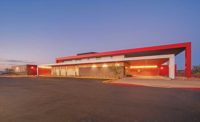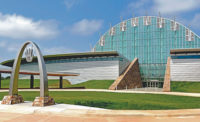Foreign Affairs Security Training Center
Blackstone, Va.
Project of the Year Finalist and Best Project
Owner: U.S. General Services Administration, Public Buildings Service, MidAtlantic Region for U.S. Dept. of State
Lead Design Firm: KieranTimberlake
General Contractor: Hensel Phelps and Mortenson Construction
Construction Manager: AECOM
Landscape Architect: GGN
Civil Engineer: Wiles Mensch Corp. with Kimley Horn and Associates Inc.
Structural Engineer: Thornton Tomasetti
MEP Engineer: Arup
Geological Engineering: ECS Mid-Atlantic LLC
Quality Assurance: Hill International
Ecological Consultant: Biohabitats
Soils Consultant: Pine & Swallow Environmental
Built at Fort Pickett in a remote area of southern Virginia, the Foreign Affairs Security Training Center (FASTC) consolidates numerous U.S. Dept. of State facilities for hard-skills training into a single location for the first time. The campus comprises 18 fully occupied buildings and 85 individual training and support structures, totaling more than 500,000 sq ft of enclosed space. Training is provided in 19 distinct venues that include firearms facilities, simulated tactical environments, two explosives pads and 19 miles of specialized driving courses.
“This one impressed me just from the sheer size,” said one judge of the $424.6-million project. “It wasn’t just the buildings … they built racetracks, firearm facilities, simulated cities to do simulated training and no building was the same.”
Crews carried out more than 1,000 acres of clearing and earthwork near sensitive and protected wetlands on the 1,350-acre site. Hundreds of acres of trees also had to be carefully cleared in protected bat species habitats. Much of the sitework occurred during some of the rainiest weather on record.
FASTC was among the first projects of its scale to be reviewed under new state stormwater regulations. The design made extensive use of low-impact development techniques to maximize infiltration, evapotranspiration and retention, while closely mimicking the predevelopment outfall condition.
More than five miles of aging municipal water infrastructure were replaced with new water lines as part of the project, providing a benefit to the nearby town of Blackstone.
Training buildings were designed to be simple, efficient and scalable, employing repeatable and economical construction systems. To maintain a consistent aesthetic and good quality control across multiple contracts, designers employed a “kit-of-parts” approach to building envelopes. That approach established common elements and materials that could be applied to various building types and help the project maintain an aggressive schedule.
Computational fluid dynamic modeling was used to design a ventilation system for the indoor/outdoor firing range. Steel trusses 16 ft deep were used as part of an open sawtooth roof structure, which assisted range ventilation while providing cover for a 200-ft by 300-ft clear span range.
A three-building grouping—including the main administration building, tactical training building and the fitness center with a café—established the campus core and point of arrival. Students begin each day at the core before being shuttled to outlying training venues.
Each outlying training venue is supported by a dedicated classroom building. These structures provide classroom space for instruction and after-action review, break rooms for students and workspace for instructors.
Labor availability was a significant issue during the four-year project, which tallied more than 1.7 million work hours. The FASTC project was constructed in a remote part of Virginia, where skilled labor is typically in short supply for large projects. With much of the work conducted during a high point in construction activity in Virginia, labor shortages were even more challenging than usual.
Given the project’s massive scope and risks associated with a tight labor market, project management was a significant challenge for the team. As the construction manager, AECOM led the risk management program during construction. The process enabled stakeholders to identify potential risks and challenges that could affect their roles in the project. AECOM also took the lead in quality assurance; contractors Hensel Phelps and Mortenson Construction oversaw quality control on their respective contracts.
Delivered in January 2020, the project was completed on time and under budget.
One judge noted that from an “execution and planning standpoint … I appreciate the complexity and what went into the Foreign Affairs project.”










Post a comment to this article
Report Abusive Comment